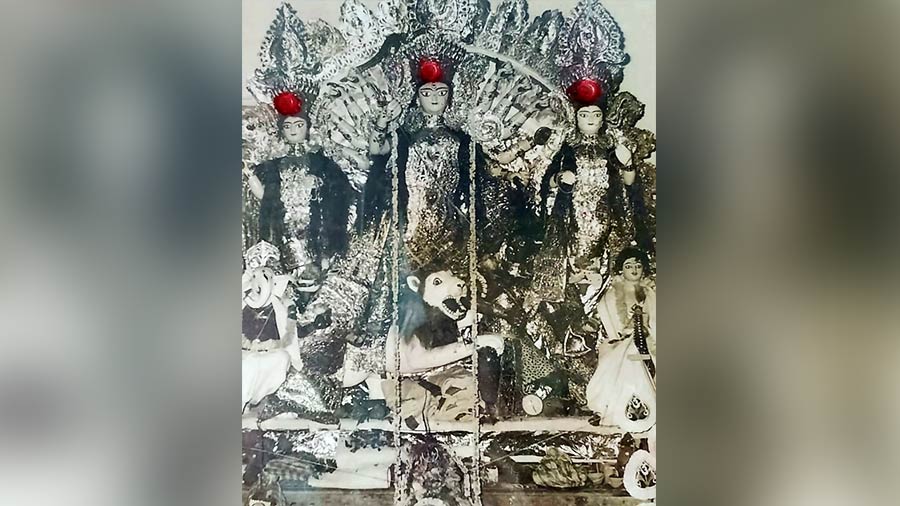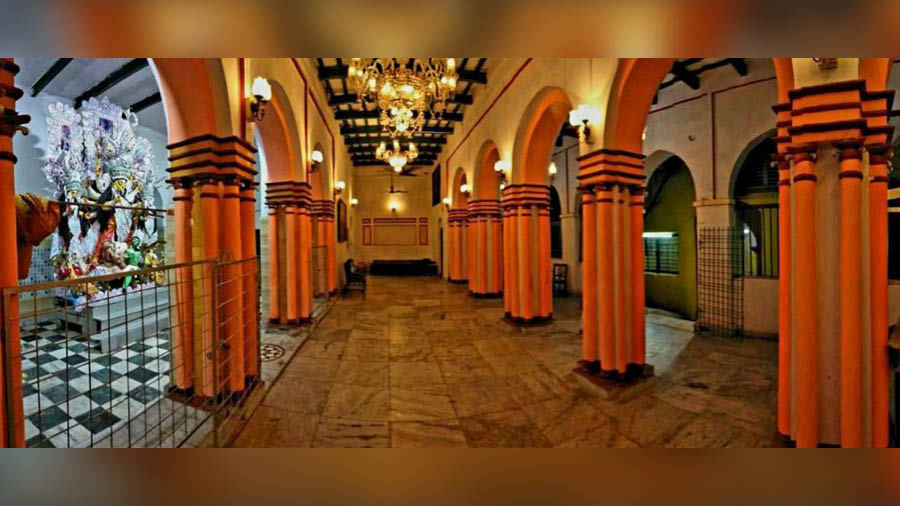The 110-year-old puja at the Nandy family’s home in Bhowanipore could be said to have born out of a ‘curse’.
The affluent trading family had moved to Kolkata from Joynagar more than 138 years ago to test their fortune in the capital of British Raj. Gangadhar Nandy, who amassed wealth by selling perfume, cosmetic, talcum powder, and fountain pens, built a huge mansion on Kansari Para Road, where he wanted to reintroduce the family’s 350-year-old tradition of worshipping Jagaddhatri but the puja could not be held as a daughter of the family accidentally died while collecting water from a pond.

The idol is typical ‘ekchala’ of Bengal school
The family priest forbade the puja and declared it cursed. Gangadhar was devastated. A few years later, he decided to perform Durga Puja at his new home in Kolkata and since then the tradition continues.
To this day, the puja is a celebration of Bengal’s tradition and religious heritage. There is probably no other puja in Bengal where so many difficult religious rituals continue to be observed with so much authenticity. Here, Durga is worshipped as a mother.
The beating of drums starts on the day of Rath Yatra, when kathamo puja, the worshipping of the wooden structure of the idol, is held. A 2.5-feet-long bamboo is worshipped that day and the same piece of bamboo is used in the right leg of the Durga idol, which is placed on the back of the lion.
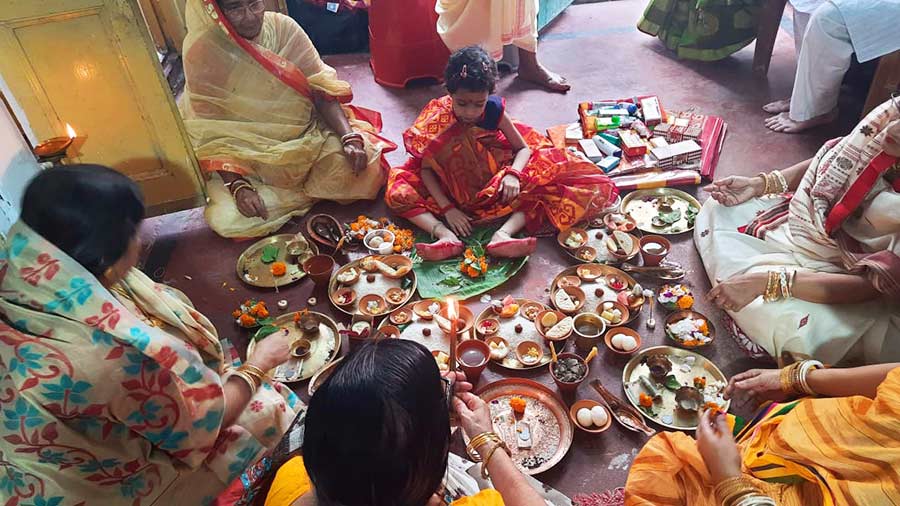
Kumari Puja, a major attraction of the family puja
“The idol is made on a platform that is shared with idols of Lakshmi, Saraswati, Kartik and Ganesh. The tradition of placing all idols on the same platform is known as ekchala protima and is symbolic of the Bengali Hindu joint family,” said Amit Nandy, 50, now the main organiser of the puja in the family.
The idol of the Nandy family is unique.

The idol of the family
Though the family hails from Joynagar in West Bengal, the face of the idol resembles the Durga idols of erstwhile East Bengal. The idol is painted bright yellow to imply tapta kanchan barna or atashi colour.
Ganesh is red with a white elephant head as the Puranas describe him as sindur shobhitam, while Saraswati is off-white. Despite sporting an African look, the lion also is white, implying a snow lion as gifted to Durga by Himalaya, according to Hindu mythology.
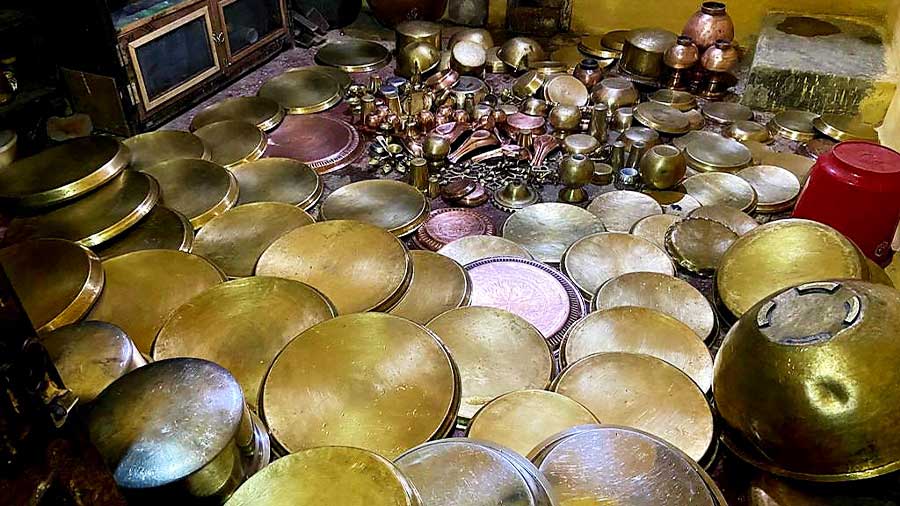
Special brass and silver utensils used in puja for decades
This puja is conducted according to Brihananda Keshwar Puran and it follows the Rajashik way of worshipping, where apart from invocating Devi Durga, one has to invoke many other Hindu gods and goddesses like Chandi, Yama, Naba Durga, Jalavashini Devi, Aranyo Vashini Devi and Kali. During Durga Puja, the family also worships Rakshash-Rakshashi, 64 yogini and Pawan Dev, the god of air.
All three priests who conduct the rituals need to recite at least 10,000 times Durga naam and Chandi path takes place five times every day.
There are three special rituals that the family follows till now. Firstly, the nabapatrika, the banana tree which is known as kola bou, is given a warm reception at home only by women of the house. The arrival of the nabapatrika is considered as the arrival of a daughter-in-law in the family and she is welcomed with exquisite alpana.
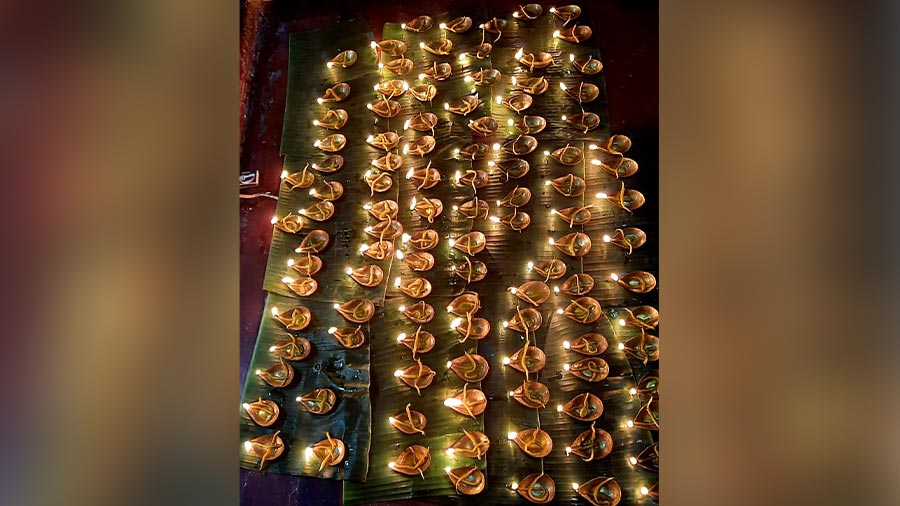
An evening during puja in the Nandy family of Bhowanipore
The second unique practice is the formation of Dhan Lakshmi, a Lakshmi idol made of paddy. It is made of grains and decorated with sari, orgaments, wooden owl and a golden coin. Dhan Lakshmi is placed before the idol and worshipped everyday with equal respect.
The puja starts with a dedication ritual called sankalpa (resolve), which is performed by a senior woman of the family and she is eligible to do it even if she is a widow. She, on behalf of her entire family, offers invocation to Devi Durga and along with that she seeks forgiveness for any sin committed by any member of her family. One who performs this tritual has to have a prescribed vegetarian meal on all four days of the Puja.
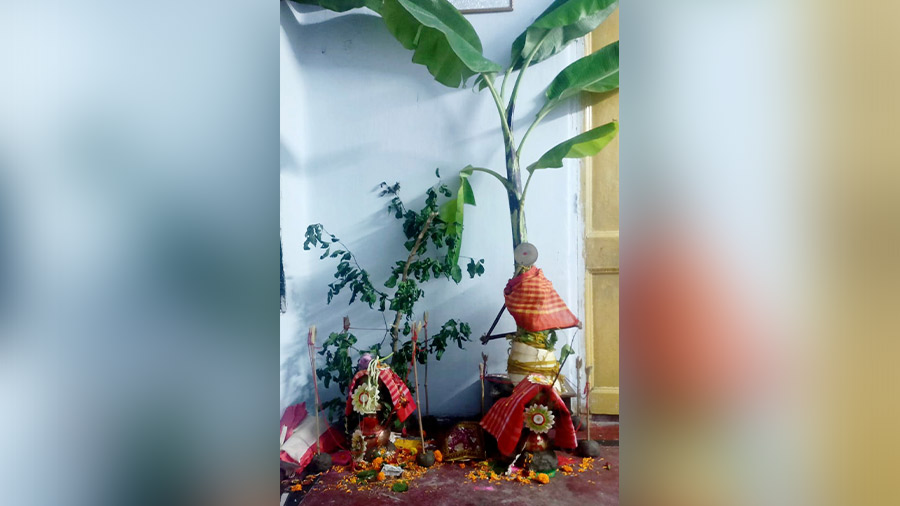
Shanti Kumbha placed at the northeast corner of the house
No animal sacrifice takes place in the Nandy family puja and Devi is never offered any non-vegetarian food. A symbolic sacrifice in the form of vegetable is conducted on Ashtami. However, the family has a tradition of worshipping arms as part of the puja.
Kumari puja, worshipping a young girl in the form of Devi Durga, takes place on Ashtami and is a popular ritual of this family. Every year, with collective consent, a young girl under nine years is selected. Today many old ladies who in their own childhood adorned the seat of Kumari in this event come to see Kumari puja.
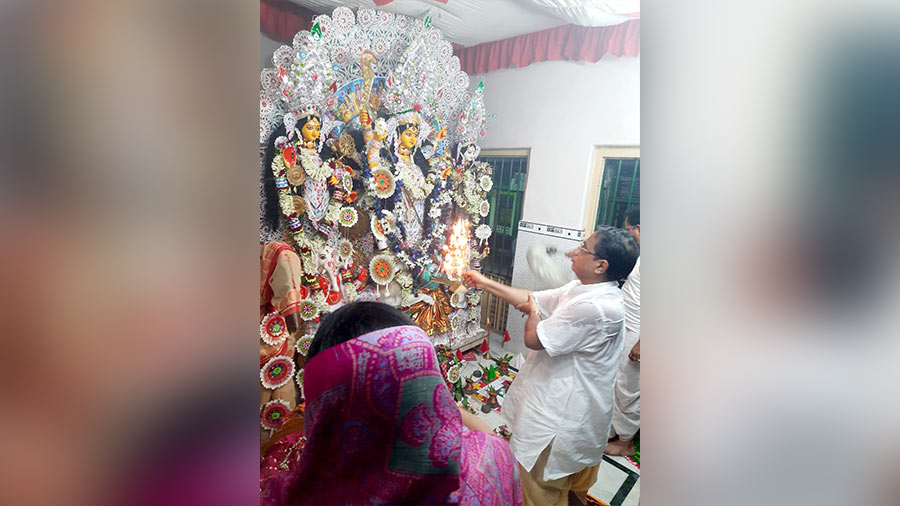
Sandhay ‘arati’
There are 16 mangal ghats placed before Durga with various prasad that include fruits, many homemade sweets, milk, luchi and betel leaf. The family offers a golden ring, nose ring and a small gold mat to the goddess.
One special mangal ghat known as Shanti Kumbha is filled with Ganga water and placed in the ishan (north-east) corner of the house on the day of Sashthi and is not immersed for the next one year. For the coming year, this Shanti Kumbha becomes the in-house deity of the family and every member of the family offers his or her respect to it before leaving home. This tradition has been followed since the inception of the puja.
The Nandy house is filled with cheering relatives and friends who come from various parts of the country on the Puja days.

Seventy-eight-year-old Sabita Nandy came to this family as a daughter-in-law nearly 60 years ago. She recalls the crowd that used to come to see the family puja in the mid-1960s and 1970s. She recalls personalities like Basanta Chowdhury, Kamal Mitra and Gyanesh Mukherjee visiting the house during Puja for lunch and adda. She even recalls Jamuna Barua of New Theatres visiting the house.
Though the family has preserved most of the traditional rituals of the puja, some have died with time. Earlier, the fire of the yagna was kept burning for three days which is not done now. Nowadays, idols are taken from Kumorpara (potters’ locality) and not made in house for space issues. There was a ritual of firing gunshots before the start of sandhi pujo, which has stopped. The idol was earlier taken to the Ganga on shoulders of porters for immersion, a practice which has been done away with.
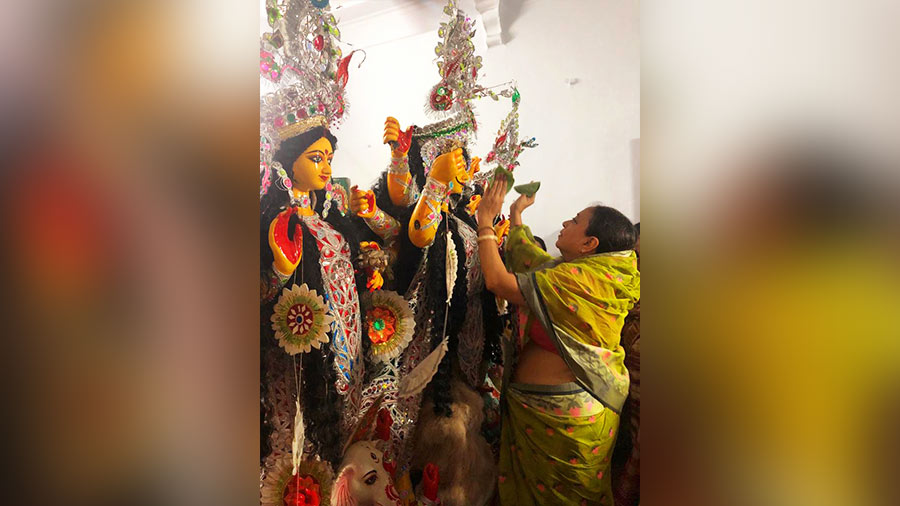
Devi ‘baran’ on Dashami before immersion
But nothing can fade the spirit of this family puja where even now, family, friends and relatives assemble to celebrate the biggest event on their annual calendar.
